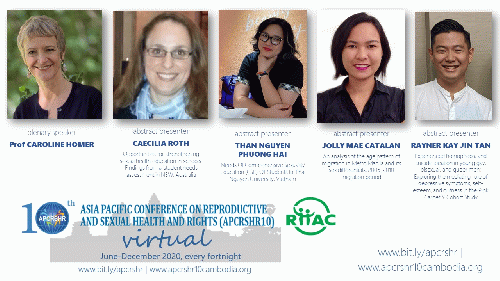
Sexual and reproductive health services are also essential services, more so during emergencies and crisis situations
(Image by CNS) Details DMCA
Approximately 1 billion young people in Asia and the Pacific region are
between 10 and 24 years old, constituting 27% of the total population in the
region. Every one of these youngsters will one day have to make life-changing
decisions that will affect their sexual and reproductive health. But research
shows that the majority of these adolescents lack the knowledge to make those
decisions responsibly.
The World Health Organization calls for investing in a life-course approach to
health, which is essential to ensure that we promote a healthy start to life,
meet the health needs of all our citizens throughout their stages of life and
accomplish the goal of improved health and well-being for all. In this regard,
sexual and reproductive health become a critical aspect of the life-course
approach to health for all as it provides opportunities, from preconception to
transitional life phases, for early investment in health promotion and disease
prevention.
"Young people in the Asia Pacific region do not have enough
knowledge of HIV, unintended pregnancies and child marriage, and there is
discrimination and stigma against LGBTIQ young people," said Prof
Caroline Homer, Co-Programme Director, Maternal, Child and Adolescent
Health at Burnet Institute, while delivering her plenary talk at the 10th Asia Pacific Conference on
Reproductive and Sexual Health and Rights (APCRSHR10) Virtual.
According to the Global Review, comprehensive sexuality education is an age-appropriate, culturally relevant approach to teaching about sexuality and relationships by providing scientifically accurate, realistic, and non-judgmental information. It leads to improved sexual and reproductive health, resulting in the reduction of sexually transmitted infections (STIs), HIV, and unintended pregnancies. It not only promotes gender equality and equitable social norms, but also has a positive impact on safer sexual behaviours, delaying sexual debut and increasing condom use.
UNFPA Regional Director for Asia and the Pacific, Bjorn Andersson, had said in APCRSHR10 Dialogues earlier: "There is a misconception that if students have access to comprehensive sexuality education, their sexual activity increases. On the contrary, it really tells one how to protect from HIV or from STIs, how not to become pregnant as a teenage girl and, more importantly, it gives a training to interact and communicate with people and to respect one another, irrespective of our gender, and where boys are told that they cannot harass girls or women. It is this kind of conversation that teaches you how to strengthen your negotiation skills in your relations and it is also about decision making."
Around 25 countries in the Asia Pacific region, including Cambodia, Bhutan, Thailand, Vietnam, Philippines, and many Pacific Island countries, are spearheading discussions around providing comprehensive sexuality education in schools. But, in many other nations or contexts, it still is a taboo subject. Anything related to the word sex is considered inappropriate and looked down upon. Neither parents/ elders nor teachers feel comfortable talking to the youngsters about it. And the consequences are there for all of us to see by way of increased sexual and other forms of gender-based violence, unintended teenage pregnancies, unsafe abortions, STIs, including HIV... the list is endless.
Even in countries that have introduced comprehensive sexuality education in the school curriculum, adolescents often do not find it adequate enough, calling for improvement in its content and teaching, as was revealed from some of the research studies presented during the ongoing APCRSHR10 Virtual conference.
While relationships, sexuality and sexual health (RSSH) education is part of the Australian school curriculum, RSSH education is not delivered in the same way at each school as teachers and schools have the flexibility to tailor the syllabus content as per local needs, said Caecilia Roth, Senior Education Officer, Family Planning, New South Wales, Australia. She shared the findings from a student needs assessment in NSW, Australia.
This study was based on an anonymous online survey in which more than 1600 New South Wales secondary-school students, aged 12-18 years (studying in grades 8-12), recruited through social media, took part. 71% of them were females, 26% males and 3% from gender-diverse groups. 61% of them were from government schools and 82% were studying in grades 10-12.
Results show that those in government schools were getting more information than those in private schools. Nearly 50% of the respondents felt it had increased their knowledge and one-third were satisfied overall with the RSSH education received. Social media was identified as the most common source of information on topics where students reported receiving the least information at school.
This reinforces the need for educators in schools to model information-seeking behaviours and build health literacy, says Roth. She also believes that "best practice is to provide age-appropriate education as children and young people develop. Better addressing of the needs of students of diverse gender and sexuality will be critical."
Another study based on online survey of 3860 students, 25 in-depth interviews and 6 focus group discussions (19433 total participants) was carried out in 5 colleges of Thai Nguyen University in Vietnam to assess the difficulties and needs of university students for comprehensive sexuality education. 60% of the respondents wanted comprehensive sexuality education as a specific learning subject, while 44% wanted the right to have access to sexual and reproductive healthcare. 44% said that there was no standard sexual and reproductive health material available to read and learn from; 36% pointed to teachers' lack of knowledge and essential skills to teach sexual and reproductive health issues; 37% complained that their families avoided even the mention of sexual and reproductive health.
Than Nguyen Phuong Hai, Programme Officer, Research Centre for Gender, Family and Environment in Development, Vietnam, who conducted the study, said, "Although each university has their related sexual and reproductive health-education activities but it does not meet the needs and expectations of their students. The students want to be educated on the topics of love and sex (53%), safe contraception and abortion methods (51%), educated about STIs and HIV (53%), prevention of sexual abuse and premarital life skills through methods of promoting students' participation like talk-shows, seminars and trainings."
From Australia to Vietnam, from teenagers to young adults, the anxieties and problems impacting the sexual and reproductive health of the youth across the region show a lot of similarities. They point to the dire need of not only including comprehensive sexuality education as part of the school/college curriculum, but also strengthening the existing sexuality education where it is available to the youth. Areas that could be improved include professional development for educators to enhance the effectiveness of lessons, and inclusion of more information about gender and sexual diversity, relationships and consent, and sexually transmissible infection testing and treatment, says Roth, adding that The International Guidance documen t, developed by UNFPA, provides guidance on what topics can be suitable for different age groups.
(Note: You can view every article as one long page if you sign up as an Advocate Member, or higher).





